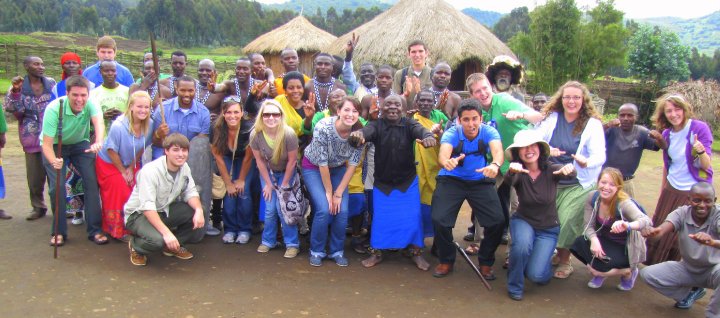Many of us woke up Thursday to nifty bird noises from an unidentified source. It was early. It sounded nice1.
Thursday was a full day and it took a lot out of all of us, I think. I will now proceed to tell you why.
Thursday A.M.:
We boarded our beloved bus in the morning and drove out of Kigali. Just for the record, bus rides are some of my favourite times with everyone. We get to just relax for a bit and hang out with each other. It’s so pleasant; it is also the source of jokes and quotes for my records.
The drive through the countryside (paysage) was so gorgeous. We were all plastered to the windows snapping away with our cameras. I’m very lucky that green is my favourite colour. The hills just keep going, and the land is covered with growth. We drove past a swamp where people probably hid during the genocide. The génocidaires would often send dogs in to find people who were hiding in the bush. That was a thought to help us prepare for what was coming…
We first visited the church at Ntarama, which is now a genocide memorial so that no one forgets what happened, in order that it should never happen again. People were all around as we parked; it struck me as interesting that they would hang around a place like that (although Bosco, our splendid driver, told us they were there to get their new national IDs2 so they could vote in the upcoming election). It would seem eerie to me if I lived there. Not that it wasn’t anyway. As we went into the main church building, the first things I saw were skulls. Sorry if that shocks…but that’s not the worst. There were shelves of bones and skulls. On the pews and hanging from rafters were the clothes of the victims, unwashed and dusty from the years they’d been there. Bosco mentioned that people fled to churches during the conflict because it was always generally known that “no one can kill you there.” How tragic that these places were desecrated so.
One of the buildings had been burnt with people in it. There were shelves of burnt and mangled belongings, books, Bibles, shoes, and other miscellaneous items. Somewhere was written: “If you knew me and you knew yourself you wouldn’t have killed me.” 5000 people were killed in Ntarama church in one day.
Fortunately, on our way to the second church site, we had a change of plans and rerouted to Rafiki Village, where we met and spoke with Patty Yoss. Rafiki Village is home to a good number of orphans who Patty and others have found based on recommendations from the government. They investigate the situation of each child and then accept some in to the Village. When the orphans arrive they are anywhere from 18 months to five years (and Rafiki only opened about 1 ½ years ago). The children live in cottages with a “mother” who cares for them. They are taught everything one would learn from a classical Christian education, plus English (required by the government) and other Rwandan curriculum items.
As the organisation moves further on in time, they plan to have the children stay until they finish secondary school, and then pay for each one’s university education. One of the goals of Rafiki is to raise the orphans to become Godly contributors to Rwanda, to help the country in many different ways with a generation of Christ-followers who, as someone said in our debriefing time that night, may end up being the leaders of Rwanda one day.
It was peacefully refreshing to play with the kiddos there after a very sobering morning. They were so beautiful and joyous. They spoke to us in English and we all played with blocks and took pictures. I got to hang out to Epa and Dadi, two little boys who were fascinated by Katey’s nice camera. The children sang songs for us, and at the end little five-year-old Naomi prayed. In that moment, I felt so small; it was pretty humbling to hear a sweet young one talk to her Father, though she has no earthly one, in such a trusting and knowing manner. As she prayed I really questioned whether the kids were supposed to help us more than we were supposed to help them.
1 My personal reflection.
2 The new IDs have no Tutsi or Hutu identification. They are just Rwandan.
23 May 2010
Subscribe to:
Post Comments (Atom)




No comments:
Post a Comment